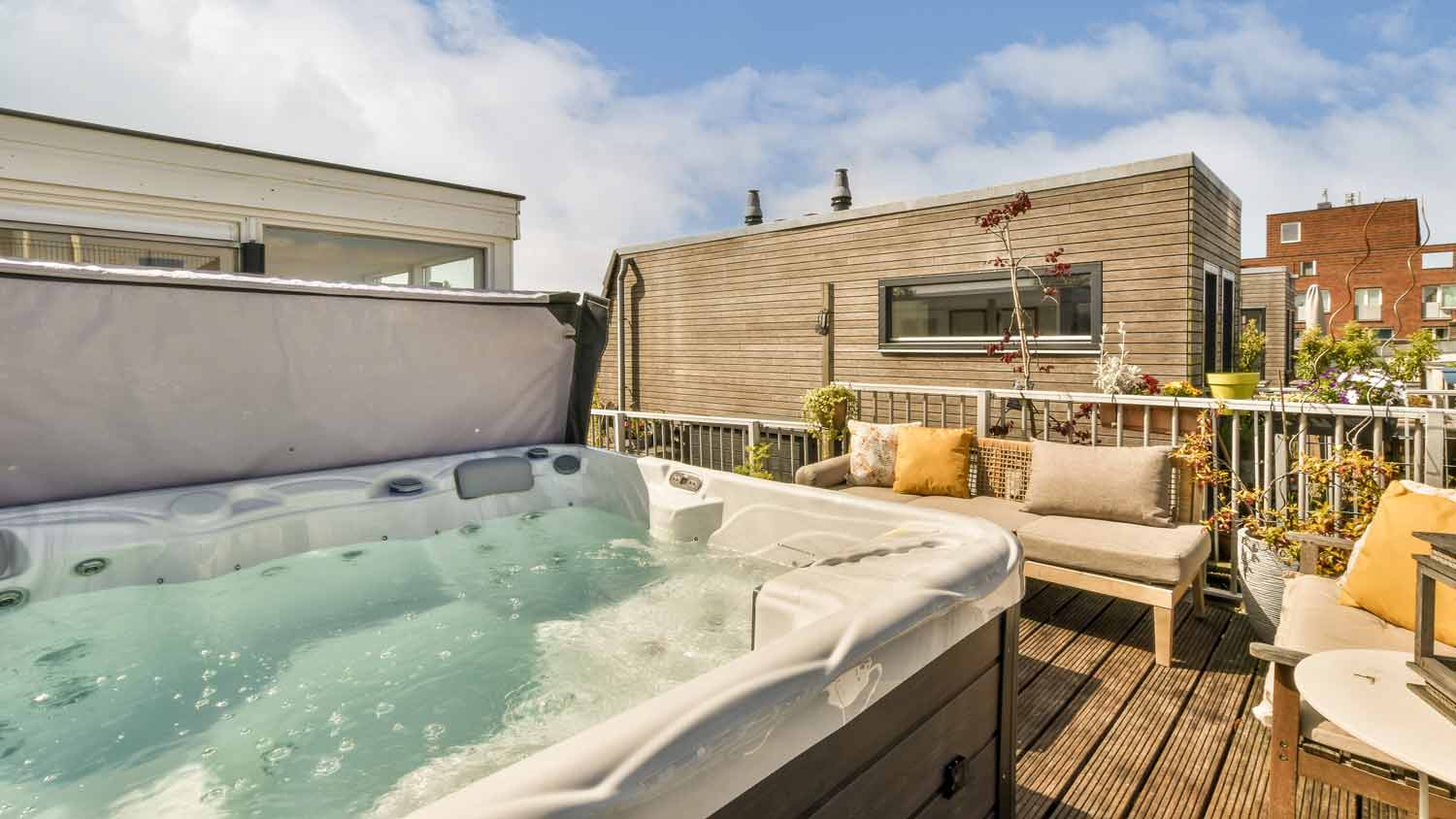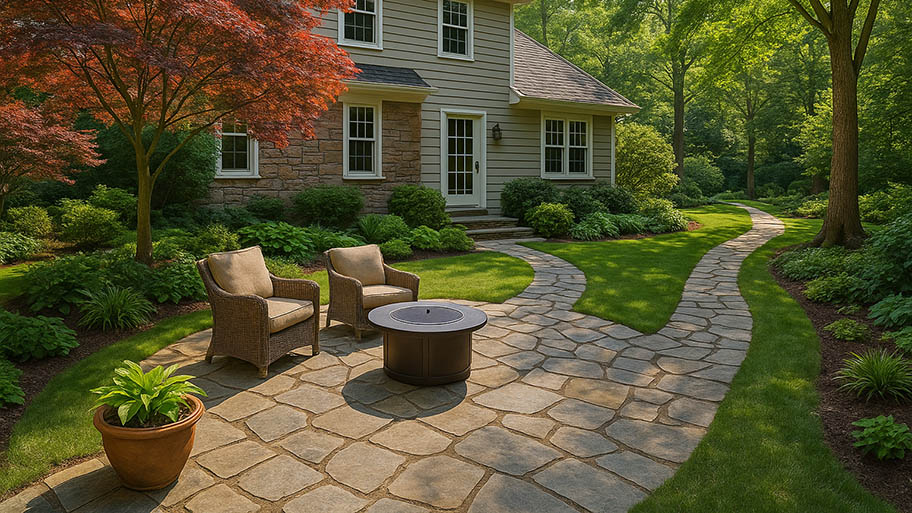
Refinishing your deck is a great way to restore its appearance and fall in love with your outdoor space. Use this guide to learn how much it costs based on factors like size and type.
Your backyard spa starts with a stable foundation


Hot tubs weigh several thousand pounds when filled.
Most decks will require additional structural support and waterproofing to accommodate a hot tub.
Hot tubs come with plumbing and, in many instances, electrical requirements.
Your project may require a permit and strict adherence to local building codes.
The average hot tub costs $6,000, but prices range from budget to high-end.
Can you put a hot tub on a deck? Many homeowners dream of soaking outdoors without the trek across the backyard. But before you fire up the water jets, there’s more to consider than what you’ll sip while enjoying the view. Installing a hot tub on a deck is a balancing act that requires careful planning and structural know-how. Here’s what it takes to bring spa days to your back door.

Placing a hot tub on your deck isn’t as simple as picking a spot and hooking it up. To do it safely and avoid costly mistakes, homeowners should consider the following factors. Remember, working with a local pool deck company is always best. They have the expertise to ensure your new spa is safe and up to code. From structural support to moisture control, here’s what you need to keep at the top of your mind.
A modestly sized hot tub that fits up to three people can weigh around 500 pounds. Once the hot tub fills with water, it becomes surprisingly heavy, weighing up to 3,000 pounds, before anyone enters. It is essential to ensure your deck has the proper structural support to withstand the extra weight and avoid warping, sagging, or total collapse.
A contractor may bring in a structural engineer to assess your deck’s framing, joists, and footings. They’ll calculate the live and dead load your deck can safely support and identify any weak points that could pose a risk over time.
Fixes for any structural issues may include additional support, such as installing more substantial joists, sistering existing beams, and pouring concrete footings beneath key load-bearing areas. Remember, working with a structural engineer ensures your deck is up to code and capable of supporting your hot tub safely for years to come.
Even if your deck was once up to code and could handle the weight of a hot tub years ago, it's essential to consider its age before proceeding.
Due to years of weather and wear and tear, older decks could have weakened boards and beams, rusted fasteners, or other types of structural erosion, compromising their load-bearing capacity. This is particularly true for wood decks. They are known for deteriorating over time because they are prone to rot, especially if they were not sealed or maintained annually.
Like a bathtub, your hot tub will need to be emptied, and spills, splashes, and the occasional overflow are inevitable. Excess moisture can seep into your deck’s structure without proper drainage and waterproofing, leading to rot, mold, mildew, and long-term damage.
All of the above is why every hot tub should have a designated system for draining water into a sewer or another appropriate outlet. You’ll also want a drainage solution beneath the deck to manage runoff and leaks, directing water safely away from the deck structure. Adding a waterproof barrier under the deck can provide extra protection by preventing water from seeping into the foundation below.
Unlike your toaster, hot tubs are not plug-and-play. They require a dedicated power source that meets specific voltage and amperage requirements. While homeowners may find smaller hot tubs that can run on 110 volts, most standard hot tubs require a 220-volt connection. Typically, your average outdoor outlet can only handle 120 volts.
To ensure safe and reliable operation, you will need to hire a local licensed electrician to install the appropriate wiring, circuit breakers, and a ground fault circuit interrupter (GFCI). A GFCI is essential for preventing electrical shock in wet environments and is often required by local building codes.
Before purchasing a hot tub, homeowners should consult their local building department to verify local guidelines and any applicable permit requirements. This is another reason to work with a contractor with expertise in this area.
Many municipalities have specific codes that regulate the installation of heavy equipment, such as hot tubs, particularly when placed on elevated or rooftop decks. These regulations ensure the structural integrity of your deck, protecting the people who use the hot tub and the investment below it. Depending on local guidelines, an inspector may need to visit after installation to ensure your hot tub is compliant.

Here’s a quick breakdown of what homeowners can expect to spend on a hot tub installation.
Hot tub prices vary widely, but most homeowners spend around $6,000.
Electrical wiring by a licensed pro for a dedicated power source can range between $600 and $2,200.
Plumbing installation is often necessary for water supply and drainage, costing anywhere from $350 to $2,000.
Deck repair or reinforcement to support the added weight could add $800 to $3,100 to your total.
Building an above-ground deck for a large hot tub typically falls within the same cost range as an above-ground pool deck.
From average costs to expert advice, get all the answers you need to get your job done.

Refinishing your deck is a great way to restore its appearance and fall in love with your outdoor space. Use this guide to learn how much it costs based on factors like size and type.

Flagstone patio costs vary by the size, material type, labor, and more. Stay tuned to see how much your flagstone patio could cost.
Deck repair costs depend on materials, damage you need to fix, and more. See how much it costs to replace or repair a deck in Columbus, OH.

Making the selection of an arbor versus a trellis depends primarily on the size of the space you want to cover with vines or climbing plants over the lattice.

Discover the cost to build an arbor in your yard. Learn about average prices, key cost factors, and tips to save on your arbor installation project.

Are you wondering what factors might affect a wraparound porch’s cost? Budget for this rustic and charming addition with our cost guide.